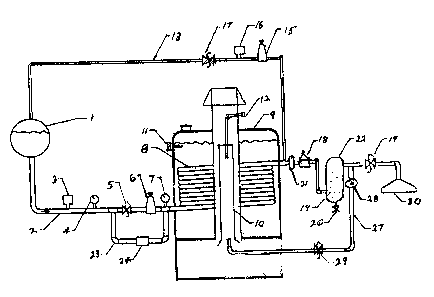Some of the information on this Web page has been provided by external sources. The Government of Canada is not responsible for the accuracy, reliability or currency of the information supplied by external sources. Users wishing to rely upon this information should consult directly with the source of the information. Content provided by external sources is not subject to official languages, privacy and accessibility requirements.
Any discrepancies in the text and image of the Claims and Abstract are due to differing posting times. Text of the Claims and Abstract are posted:
| (12) Patent Application: | (11) CA 2791305 |
|---|---|
| (54) English Title: | L.P.G. VAPORIZER FOR PROPANE, BUTANE ETC. FOR GAS BURNING EQUIPMENT |
| (54) French Title: | VAPORISATEUR DE GAZ DE PETROLE LIQUEFIES POUR LE PROPANE, LE BUTANE, ETC. POUR UN EQUIPEMENT DE COMBUSTION DE GAZ |
| Status: | Deemed Abandoned and Beyond the Period of Reinstatement - Pending Response to Notice of Disregarded Communication |
| (51) International Patent Classification (IPC): |
|
|---|---|
| (72) Inventors : |
|
| (73) Owners : |
|
| (71) Applicants : |
|
| (74) Agent: | |
| (74) Associate agent: | |
| (45) Issued: | |
| (22) Filed Date: | 2012-10-15 |
| (41) Open to Public Inspection: | 2014-04-15 |
| Availability of licence: | N/A |
| Dedicated to the Public: | N/A |
| (25) Language of filing: | English |
| Patent Cooperation Treaty (PCT): | No |
|---|
| (30) Application Priority Data: | None |
|---|
The vaporizer changes liquified petroleum gas ( propane, butane,etc. ) to
vapor for gas
burning equipment. The vaporizer is installed downstream from the liquified
petroleum
gas (L.P.G.) supply tank and before the utilizing gas equipment (eg.,
industrial &
construction heating, grain dryers ,asphalt heating etc.).
Note: Claims are shown in the official language in which they were submitted.
Note: Descriptions are shown in the official language in which they were submitted.

2024-08-01:As part of the Next Generation Patents (NGP) transition, the Canadian Patents Database (CPD) now contains a more detailed Event History, which replicates the Event Log of our new back-office solution.
Please note that "Inactive:" events refers to events no longer in use in our new back-office solution.
For a clearer understanding of the status of the application/patent presented on this page, the site Disclaimer , as well as the definitions for Patent , Event History , Maintenance Fee and Payment History should be consulted.
| Description | Date |
|---|---|
| Time Limit for Reversal Expired | 2017-10-17 |
| Application Not Reinstated by Deadline | 2017-10-17 |
| Inactive: Abandon-RFE+Late fee unpaid-Correspondence sent | 2017-10-16 |
| Inactive: Correspondence - Prosecution | 2017-08-03 |
| Inactive: Correspondence - Prosecution | 2017-07-31 |
| Amendment Received - Voluntary Amendment | 2017-07-24 |
| Inactive: Correspondence - MF | 2017-07-24 |
| Inactive: Correspondence - MF | 2017-07-17 |
| Inactive: Correspondence - MF | 2017-07-17 |
| Amendment Received - Voluntary Amendment | 2017-07-17 |
| Inactive: Correspondence - MF | 2017-07-17 |
| Amendment Received - Voluntary Amendment | 2017-07-17 |
| Amendment Received - Voluntary Amendment | 2017-07-17 |
| Inactive: Office letter | 2017-07-05 |
| Deemed Abandoned - Failure to Respond to Maintenance Fee Notice | 2016-10-17 |
| Maintenance Request Received | 2015-09-18 |
| Maintenance Request Received | 2014-09-15 |
| Application Published (Open to Public Inspection) | 2014-04-15 |
| Inactive: Cover page published | 2014-04-14 |
| Inactive: IPC assigned | 2012-11-16 |
| Inactive: First IPC assigned | 2012-11-16 |
| Inactive: Inventor deleted | 2012-11-14 |
| Inactive: Correspondence - Formalities | 2012-11-05 |
| Application Received - Regular National | 2012-10-16 |
| Inactive: Request under s.37 Rules - Non-PCT | 2012-10-16 |
| Reinstatement Requirements Deemed Compliant for All Abandonment Reasons | 2012-10-16 |
| Inactive: Filing certificate - No RFE (English) | 2012-10-16 |
| Small Entity Declaration Determined Compliant | 2012-10-15 |
| Abandonment Date | Reason | Reinstatement Date |
|---|---|---|
| 2016-10-17 |
The last payment was received on 2015-09-18
Note : If the full payment has not been received on or before the date indicated, a further fee may be required which may be one of the following
Patent fees are adjusted on the 1st of January every year. The amounts above are the current amounts if received by December 31 of the current year.
Please refer to the CIPO
Patent Fees
web page to see all current fee amounts.
| Fee Type | Anniversary Year | Due Date | Paid Date |
|---|---|---|---|
| Application fee - small | 2012-10-15 | ||
| MF (application, 2nd anniv.) - small | 02 | 2014-10-15 | 2014-09-15 |
| MF (application, 3rd anniv.) - standard | 03 | 2015-10-15 | 2015-09-18 |
Note: Records showing the ownership history in alphabetical order.
| Current Owners on Record |
|---|
| ALLEN A. NEUFELDT |
| Past Owners on Record |
|---|
| None |